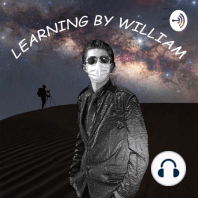27 min listen

On December 21st, the “Great Conjunction” of Jupiter and Saturn Will Occur. Here is What That Means:
On December 21st, the “Great Conjunction” of Jupiter and Saturn Will Occur. Here is What That Means:
ratings:
Length:
28 minutes
Released:
Dec 19, 2020
Format:
Podcast episode
Description
5 out of the 7 extraterrestrial planets in our solar system were discovered by the same man; his name was Galileo Galilei. In 1609, after hearing about Hans Lippershey’s Dutch Perspective Glasses, Galileo designed his own telescope.. In only a few days, without ever having seen one. This telescope was orders of magnitude better than Lippershey’s patented telescope, and allowed him to explore the cosmos in a way unheard of before. He discovered Venus, Mars, Jupiter, and Saturn, all with that same telescope he had recently built. As time progressed forwards, the telescopes we used progressed as well. We went from the small 30x magnification telescope of the Galilean age to the massive, 30 meter aperture observatories that could magnify objects orders of magnitude more than Galileo’s. The telescope is, without a doubt, the most important scientific invention that has ever existed; with it, Galileo discovered four planets and Jupiter’s moons, William Herschel discovered Uranus and formulated the Catalogue of Nebulae and Clusters of Stars, Charles Messier detailed 110 large deep sky objects in a catalogue known as the Messier Catalogue, Edwin Hubble discovered the Hubble Constant (~70 km/s per megaparsec), Gerard Kuiper discovered the CO2 content on Mars and the icy rings of Saturn, and how Carl Sagan learned the riches of the cosmos and sought to communicate it to all corners of the earth. While telescopes are the greatest piece of technology humans have ever created, it is not practical for everything. There are some events that are so incredible and obvious that we can see them with our naked eyes, with nothing but our eyes and a passion for the night sky. December 21st is one of those times, as Jupiter and Saturn will come within .1 degrees of each other in the night sky in what is known as the Great Conjunction, forming a superstar that has not been visible to humans since 1226.
If you have any questions, comments, concerns, or corrections, please email me using the address provided: learningbywilliam@gmail.com
References:
Inventors and Developers of the Telescope
https://www.space.com/21950-who-invented-the-telescope.html
Galileo Galilei- Information
https://en.wikipedia.org/wiki/Galileo_Galilei
Great Conjunction of Jupiter and Saturn
https://en.wikipedia.org/wiki/Great_conjunction
Conjunctions in Astronomy
https://en.wikipedia.org/wiki/Conjunction_(astronomy)
Ecliptic Coordinate System - Celestial Sphere in Astronomy
https://en.wikipedia.org/wiki/Ecliptic_coordinate_system
The Star of Bethlehem and its Theoretical Relation to the Great Conjunction
https://en.wikipedia.org/wiki/Star_of_Bethlehem
EDIT: A correction has been made to the number of planets Galileo discovered. In thee description and in the podcast, it was said that Galileo discovered four planets- Venus, Mars, Jupiter, and Saturn, but Galileo actually discovered five- includes Mercury.
If you have any questions, comments, concerns, or corrections, please email me using the address provided: learningbywilliam@gmail.com
References:
Inventors and Developers of the Telescope
https://www.space.com/21950-who-invented-the-telescope.html
Galileo Galilei- Information
https://en.wikipedia.org/wiki/Galileo_Galilei
Great Conjunction of Jupiter and Saturn
https://en.wikipedia.org/wiki/Great_conjunction
Conjunctions in Astronomy
https://en.wikipedia.org/wiki/Conjunction_(astronomy)
Ecliptic Coordinate System - Celestial Sphere in Astronomy
https://en.wikipedia.org/wiki/Ecliptic_coordinate_system
The Star of Bethlehem and its Theoretical Relation to the Great Conjunction
https://en.wikipedia.org/wiki/Star_of_Bethlehem
EDIT: A correction has been made to the number of planets Galileo discovered. In thee description and in the podcast, it was said that Galileo discovered four planets- Venus, Mars, Jupiter, and Saturn, but Galileo actually discovered five- includes Mercury.
Released:
Dec 19, 2020
Format:
Podcast episode
Titles in the series (65)
Authoritarianism is Damaging to the Pursuit of Science and Knowledge- Here are a few Scientists who Stood Their Scientific Ground Against Authoritarianism by Learning by William